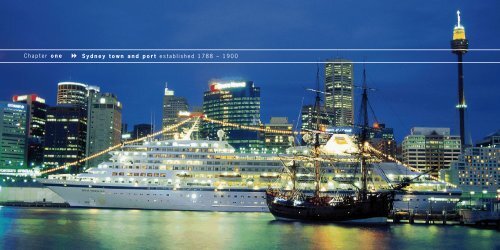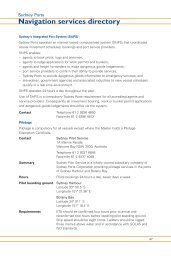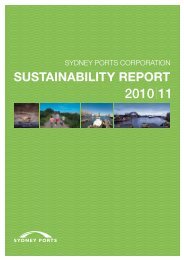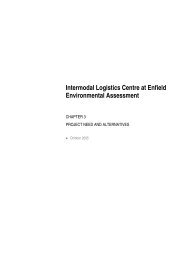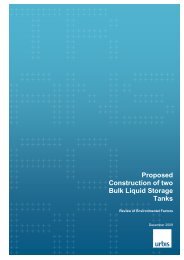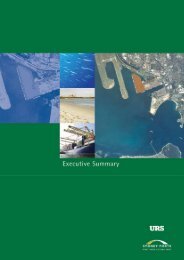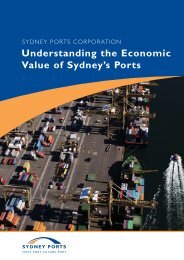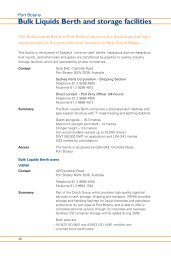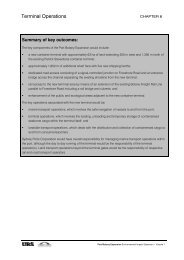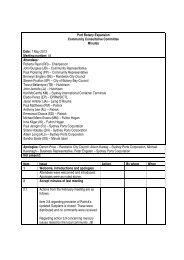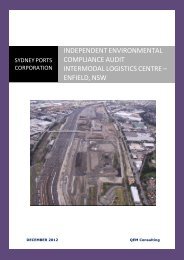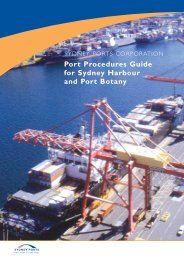Chapter 1..... - Sydney Ports
Chapter 1..... - Sydney Ports
Chapter 1..... - Sydney Ports
You also want an ePaper? Increase the reach of your titles
YUMPU automatically turns print PDFs into web optimized ePapers that Google loves.
<strong>Chapter</strong> one<br />
<br />
<strong>Sydney</strong> town and port established 1788 – 1900
<strong>Sydney</strong> town and port established 1788 – 1900<br />
<br />
From the time of <strong>Sydney</strong>’s establishment as<br />
a penal settlement in 1788, the appeal of<br />
the location was the harbour and its water<br />
supply from the Tank Stream. Those features<br />
drew Britain’s Captain Arthur Phillip to<br />
disembark his mostly convict First Fleet<br />
party of 1,500 at <strong>Sydney</strong> Cove. Over the<br />
ensuing two centuries, the beauty and<br />
potential of <strong>Sydney</strong> Harbour, also known<br />
as Port Jackson, attracted settlers, traders,<br />
visitors and business people whose energy,<br />
innovation and vision contributed to the<br />
And it was the harbour that enabled <strong>Sydney</strong> to develop as a major trading centre of<br />
the South Pacific. From the outset, <strong>Sydney</strong> derived considerable wealth from its role<br />
as a port, while the harbour became internationally admired for its visual grandeur.<br />
The development of the city and the port, and the proximity of each to the other,<br />
however, over time led to conflict and tensions.<br />
In 1788 <strong>Sydney</strong> filled a void for England, offering a harbour to accommodate convict<br />
ships that, following the American War of Independence, could no longer unload<br />
their human cargo in the United States. Named after Britain’s Secretary of State,<br />
Lord <strong>Sydney</strong> – who had sent Captain Phillip to Australia to start the penal settlement<br />
– the city’s development is inextricably woven in with the story of its harbour,<br />
which has extensively shaped its character and destiny.<br />
The early years in new <strong>Sydney</strong> town were challenging, with the Tank Stream proving<br />
an erratic source of water and most goods having to be imported, leaving the growing<br />
town hugely reliant on shipping. A need for wharves was apparent from the outset:<br />
the first recorded mention of wharfage, according to F. Matthews’s ‘Development of<br />
Wharfage—<strong>Sydney</strong> Harbour’, was made by David Collins, first Judge Advocate, who<br />
stated that ‘a wharf for the convenience of loading stores was begun in 1788’ and<br />
that in 1789 ‘some of the hands were employed at building wharves’. Frank Clune,<br />
in his ‘Saga of <strong>Sydney</strong>’, writes that the first wharf built was a landing stage on the<br />
western side of <strong>Sydney</strong> Cove, on the site of what was later the Maritime Services<br />
Board building and, from the late 1980s, the Museum of Contemporary Art. The<br />
early wharves, built under instruction from the governor and known as Hospital<br />
Wharf and Governor’s Wharf, were little more than insubstantial frameworks of<br />
logs filled with earth. Hospital Wharf, later King’s then Queen’s Wharf, subsequently<br />
disappeared as Circular Quay was extended in 1854–55.<br />
<strong>Sydney</strong>’s Circular Quay in 1890 – an area of<br />
constant change, then and now.<br />
city’s growth.<br />
Growth was swift as the expanding settlement attracted more and more people.<br />
The East India Company’s monopoly on trading rights, which was not broken until<br />
1813, was a hindrance but, despite that, <strong>Sydney</strong>’s maritime trade grew. A boost<br />
came after 1796 when Spanish-American ports closed against British ships because<br />
of war, and British whalers turned to <strong>Sydney</strong>’s Port Jackson, the harbour named,
<strong>Chapter</strong> one<br />
<strong>Sydney</strong> town and port established 1788 – 1900<br />
18<br />
Wharf-building crews were kept busy as berthing facilities expanded to accommodate increasing ferry traffic on <strong>Sydney</strong> Harbour.<br />
but never entered, by Captain James Cook in 1770. British and American whalers<br />
took to using <strong>Sydney</strong> as a base and whale-oil became an important export. Seal-skins<br />
and timber were also shipped to the UK. Further activity was in coastal shipping,<br />
carrying timber, meat and coal from Newcastle to <strong>Sydney</strong>. Most commercial ships<br />
anchored in and around <strong>Sydney</strong> Cove; port authorities directed ‘foreign’ ships to an<br />
area designated by Governor Phillip, opposite <strong>Sydney</strong> Cove and known as Neutral<br />
Bay, so that they could not turn their guns on <strong>Sydney</strong> Town.<br />
A name associated with early wharfage in <strong>Sydney</strong> was that of its first true merchant,<br />
Robert Campbell, an entrepreneurial Scot who arrived in 1798 from Calcutta to<br />
start an import-export business. Campbell, often referred to as the ‘father of<br />
Australian commerce’, bought leases of waterfront land on the western side of<br />
<strong>Sydney</strong> Cove and in 1803 built a warehouse and <strong>Sydney</strong>’s first private wharf, which,<br />
for many years, was a berth for visiting vessels. Campbell’s business flourished in<br />
The Rocks, which became notorious as a rowdy dockside district in the early 1800s,<br />
with sailors from whaling and other vessels enjoying the hospitality of its many<br />
pubs. Several tavern-keepers supplemented their incomes by helping procure sailors<br />
for ships’ captains seeking fresh crews, a practice helped if the pub had a trapdoor<br />
through which an unsuspecting drunk could be dropped and bundled along a tunnel<br />
to the waterfront and aboard ship.<br />
Several tavern-keepers<br />
supplemented their<br />
income by helping procure<br />
sailors for ships’ captains<br />
seeking fresh crews, a<br />
practice helped if the<br />
pub had a trapdoor through<br />
which an unsuspecting<br />
drunk could be dropped<br />
and bundled along a<br />
tunnel to the waterfront<br />
and aboard ship.<br />
Energetic growth in wool and whaling<br />
industries gave the economy a strong<br />
stimulus. Wool ranks as an important<br />
early industry for <strong>Sydney</strong>. A pioneer of<br />
the industry, John Macarthur, imported<br />
Spanish merinos and rams from South<br />
Africa in 1796 and began breeding<br />
on what became Australia’s first largescale<br />
sheep farm, south of <strong>Sydney</strong>.<br />
In 1807 <strong>Sydney</strong> sent its first shipment<br />
of wool to England, launching what<br />
became a staple export. Wool exports<br />
soared in the prosperous 1830s as<br />
Australia’s importance increased as<br />
a source of wool for the UK’s mills.<br />
<strong>Sydney</strong> Cove was a busy cluster of<br />
woolstores and wooltraders.<br />
A large woolstore was opened in 1850<br />
at Circular Quay by Thomas Sutcliffe<br />
Mort, who had arrived in <strong>Sydney</strong> as a<br />
22-year-old clerk in a woolbuying firm<br />
in 1838. Mort opened his own business<br />
as a woolbroker and went on to become<br />
another of <strong>Sydney</strong>’s early merchant<br />
princes. His name lives on in Mort Bay<br />
in Balmain, where in 1854 he built a dry<br />
dock for overhauling the steamships<br />
that travelled between Australia and<br />
the UK. Over the years the dock was<br />
expanded and new slipways built;<br />
several steamers used in Australian<br />
coastal trade were built there in the<br />
1850s and 1860s. Mort also laid the<br />
basis for one of Australia’s leading<br />
pastoral companies, Goldsbrough Mort.<br />
By 1850 the UK was taking more than<br />
half of its imported wool from Australia.<br />
This growth in the wool trade gave<br />
impetus to other local industries<br />
servicing agriculture and providing<br />
domestic supplies such as food, drink<br />
and clothing. Also in the 1850s gold<br />
was discovered around Bathurst, to<br />
the west of <strong>Sydney</strong>, and the gold rush<br />
stimulated further prosperity, with<br />
gold at times overtaking wool as a<br />
major export earner. In 1879 the first<br />
shipment of frozen beef and mutton<br />
was successfully dispatched from<br />
<strong>Sydney</strong> to London, adding another<br />
flourishing export for <strong>Sydney</strong>. This<br />
achievement, building on earlier trials,<br />
was eventually the result of the efforts<br />
of brothers Thomas and Andrew McIlwraith<br />
and Malcolm McEacharn; it also saw the<br />
realisation of a dream of Thomas Mort,<br />
who had devoted much time and money<br />
to trials in refrigeration but had died<br />
in 1878, a year before his vision<br />
became reality.<br />
By 1850 the UK was<br />
taking more than half<br />
of its imported wool<br />
from Australia.<br />
19
<strong>Chapter</strong> one<br />
<strong>Sydney</strong> town and port established 1788 – 1900<br />
20<br />
By 1832 <strong>Sydney</strong>’s trade had increased to a point where additional wharf accommodation<br />
became essential. In the following year the British Admiralty declared <strong>Sydney</strong> a<br />
free port, legitimising trade by vessels of foreign nations. Adequate wharfage was<br />
urgently needed. In July 1833 a council was appointed to examine plans to build<br />
a semi-circular quay at the head of <strong>Sydney</strong> Cove. Its report, delivered in 1836,<br />
approved of<br />
‘a plan for forming a circular quay from the east to<br />
the west side of the Cove, which would be capable<br />
of extension by scarping the rocky shore along the<br />
eastern side of the Cove… About two acres of solid<br />
land was to be reclaimed from the mud and silt, and<br />
there were proposals for continuing the main streets<br />
to the water and erecting a number of public offices<br />
around the new Quay…‘<br />
21<br />
Reclaiming the tidal flats of the Tank Stream estuary transformed the area. Dredging<br />
began in 1841 and by 1847 the western end of the stone wall was completed, mostly<br />
by convict labour. Because the head of the cove formed a 180-degree curve, the<br />
area became known as Semi-Circular Quay. Subsequent construction of jetties, and<br />
then a railway and road, changed the shape of the quay from curves to straight<br />
lines, but the name Circular Quay endures. In the mid-1800s, with accommodation<br />
for about 30 ships, it was able to cope with the big increase in activity in the wool<br />
and gold industries. Wool became the staple export in the 1860s—the apogee of<br />
the era of sailing ships—when trade in whale-oil products tapered off, although<br />
gold remained important.<br />
Padbury’s Wharf, between <strong>Sydney</strong>’s Dawes Point and Millers Point, circa 1900. The area was later<br />
renamed Walsh Bay, after Commissioner Henry Walsh of the <strong>Sydney</strong> Harbour Trust.
<strong>Chapter</strong> one<br />
<strong>Sydney</strong> town and port established 1788 – 1900<br />
22<br />
23<br />
Before the construction of the <strong>Sydney</strong> Harbour Bridge, opened in 1932, steam-powered ferries were the main link between the shores of <strong>Sydney</strong> Harbour.
<strong>Chapter</strong> one<br />
<strong>Sydney</strong> town and port established 1788 – 1900<br />
24<br />
Woolloomooloo Bay, <strong>Sydney</strong>, circa 1900.<br />
Writing in A Historial Geography of<br />
the British Dominions, J.D. Rodgers<br />
commented:<br />
‘<strong>Sydney</strong> was commercial<br />
queen of the Southern<br />
Hemisphere; and the<br />
commerce of <strong>Sydney</strong><br />
meant wool. Wool was<br />
the only export which<br />
grew increasingly,<br />
unremittingly in every<br />
Australian colony. It left<br />
its Australian rivals far<br />
behind.’<br />
Development in Woolloomooloo Bay<br />
began in the 1860s, extending the<br />
boundaries of the Port of <strong>Sydney</strong>.<br />
Cowper Wharf, built in 1863, was the<br />
first wharf of significance built after<br />
responsible government was established<br />
in 1856. The government went on to<br />
build a group of capacious wharves at<br />
Woolloomooloo. By 1870 the number<br />
of ships entering <strong>Sydney</strong> Harbour was<br />
six times that of 40 years earlier. The<br />
government retained some control over<br />
<strong>Sydney</strong> Cove’s Semi-Circular Quay but in<br />
neighbouring Darling Harbour and the<br />
deep waters later known as Walsh Bay the<br />
situation was increasingly disorganised.<br />
Darling Harbour, known for the first<br />
40 years after settlement as Cockle Bay<br />
because of the vast quantities of cockles,<br />
mussels and oysters found there, was<br />
later renamed after Governor Ralph<br />
Darling. In the 1870s it was not a<br />
pleasant spot, with waste and offal<br />
from nearby abattoirs running into the<br />
harbour, an open sewage outlet and the<br />
threat of dangerous sharks attracted by<br />
dumped animal carcasses.<br />
Later in the 1880s Cockatoo Island and<br />
Balmain were established as shipbuilding<br />
and repair areas. Thus the steady growth<br />
of the Port of <strong>Sydney</strong> was evident in the<br />
rise in wharfage and waterfront industries,<br />
bond and free stores, residences and<br />
offices. Australia’s trade continued<br />
to grow, reflecting the vigour of<br />
agriculture and commercial activities,<br />
with commensurate growth in ships<br />
carrying exports and imports and<br />
servicing coastal and interstate markets.<br />
The costs of unregulated growth, however,<br />
were becoming apparent. Waterfront<br />
streets were narrow and cramped,<br />
pollution control non-existent and,<br />
overall, the improvement in port facilities<br />
was not keeping up with the expansion<br />
in trade, resulting in congestion and<br />
delays. A failure to achieve coordinated<br />
activity reflected the absence of planning<br />
for port development.<br />
The Public Works Department had been<br />
responsible for building new wharves and<br />
extending and repairing older structures.<br />
An initial step towards establishing<br />
disciplined management of the Port<br />
of <strong>Sydney</strong> had been taken in 1880<br />
with the passing of the Wharfage and<br />
Tonnage Rates Act which, in addition<br />
to revising berthing fees, defined a<br />
public wharf. New wharves were built<br />
on the eastern side of Circular Quay<br />
and in 1883 the French shipping line<br />
Messageries Maritimes became the first<br />
shipping company to lease a government<br />
wharf under the conditions of the new<br />
act. Burns, Philp and Company took a<br />
berth in the following year.<br />
By 1900 <strong>Sydney</strong> had some eight miles<br />
of wharves, with the main cargo berths<br />
at Darling Harbour, Woolloomooloo and<br />
Pyrmont. Many of the timber wharves<br />
were privately owned and it was<br />
not uncommon for the interests of<br />
neighbouring wharf owners to conflict.<br />
Limits for extensions of wharves were<br />
25
<strong>Chapter</strong> one<br />
<strong>Sydney</strong> town and port established 1788 – 1900<br />
26<br />
set by<br />
Circular Quay, ever a bustling scene, shown here<br />
at 9 am in the late 1920s with the trams that were<br />
a feature of the city until the early 1960s.<br />
set by several government departments,<br />
leading to considerable uncertainty.<br />
To create some kind of cohesion, the<br />
private wharf owners formed a Wharf<br />
Association with a manager and staff;<br />
public wharves were controlled by the<br />
Public Wharves Department under a<br />
manager and collector. Dissatisfaction<br />
with port administration, however, was<br />
rife and increasing, and a comprehensive<br />
harbour improvement scheme was<br />
needed to provide solutions to the<br />
chronic problems of maintaining<br />
wharves, sheds and related facilities.<br />
And in the late 1800s a great change<br />
was occurring in the shipping arriving<br />
in <strong>Sydney</strong> port, with steamships<br />
increasingly taking the place of the<br />
sailing ships. Another shift was a visible<br />
increase in shipping from nations other<br />
than Britain. <strong>Sydney</strong>’s basic facilities<br />
were being swamped by demand. It was<br />
clear that, to improve conditions, the<br />
government would have to intervene in<br />
managing the port.<br />
Managing the Port of <strong>Sydney</strong><br />
From the outset there was a recognition<br />
of a need to control the volume and<br />
variety of shipping entering and leaving<br />
the port, to manage anchorage and,<br />
later, wharfage areas. Governor Phillip’s<br />
early colonial administration established<br />
a signal station and beacon at South<br />
Head, instituted pilotage services and<br />
built two wharves at <strong>Sydney</strong> Cove. Port<br />
dues were first levied in 1800.<br />
More formal port management dates<br />
from 1811 when Governor Macquarie<br />
appointed the first harbourmaster,<br />
Robert Watson (after whom Watsons<br />
Bay is named), to supervise pilotage.<br />
Pilotage fees were fixed in 1813. Then,<br />
in 1814, Captain John Piper (Point<br />
Piper was named after him) became<br />
‘Naval Officer’ of Port Jackson, with<br />
the authority to collect harbour and<br />
customs dues and supervise activities<br />
such as pilotage and berths. Payments<br />
of rates were made to Piper, who<br />
received no salary but was allowed<br />
a percentage of the dues collected.<br />
The form of administration was reviewed<br />
and changed many times in the years<br />
that followed as successive regimes<br />
sought to keep pace with change<br />
and growth in the ports. While the<br />
organisations have changed shape<br />
and name, an uninterrupted line of<br />
administration has come down through<br />
the years from the early harbourmasters,<br />
pilotage and marine boards, the <strong>Sydney</strong><br />
Harbour Trust and the NSW Department<br />
of Navigation to the Maritime Services<br />
Board and today’s <strong>Sydney</strong> <strong>Ports</strong><br />
Corporation.<br />
A system of providing pilots to guide<br />
ships up <strong>Sydney</strong> Harbour to anchor at<br />
<strong>Sydney</strong> Cove had been in place since<br />
1805 but it was not until 1825 that<br />
pilotage was made compulsory in<br />
<strong>Sydney</strong> port and a Pilotage Board was<br />
established to oversee pilots. A Steam<br />
Navigation Board was established in<br />
1853 to administer laws regarding<br />
steamships, ferry services, harbours<br />
and navigable waters. This board was<br />
dissolved in 1862 and in the following<br />
year an amalgamation of the Navigation<br />
and Pilotage Boards produced a new<br />
authority, Steam Navigation and Pilot<br />
Board and Harbour Department.<br />
An important development in<br />
administration occurred in 1871 with<br />
the passing of a Navigation Act creating<br />
the Marine Board of NSW, which had the<br />
powers to supervise the issue, suspension<br />
and cancellation of certificates of<br />
competency and service, frame harbour<br />
regulations, preserve ports, license and<br />
remove pilots, regulate lighthouses and<br />
manage moorings.<br />
Growing sense of crisis in city<br />
administration from the 1880s<br />
The end of the nineteenth century saw<br />
the government’s first serious attempt<br />
at planning for coordinated development<br />
and improvement of port facilities.<br />
Until then, most of the work in providing<br />
and maintaining wharves had been<br />
left to shipping companies and private<br />
individuals. The number of wharves<br />
increased haphazardly during the<br />
century as trading companies established<br />
facilities unconstrained by government<br />
control and in the absence of any official<br />
planning. As a consequence, when<br />
bubonic plague hit, the condition of the<br />
<strong>Sydney</strong> waterfront and nearby properties<br />
enabled diseased rats to proliferate and<br />
spread their disease further.<br />
27


